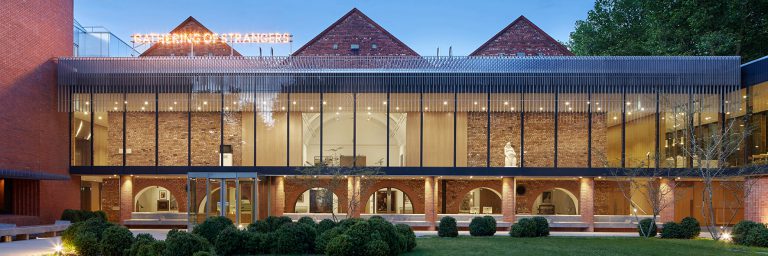
Some of the best Galleries & Museums in Manchester are here on Oxford Road Corridor. Explore a diverse programme for all cultural enthusiasts.

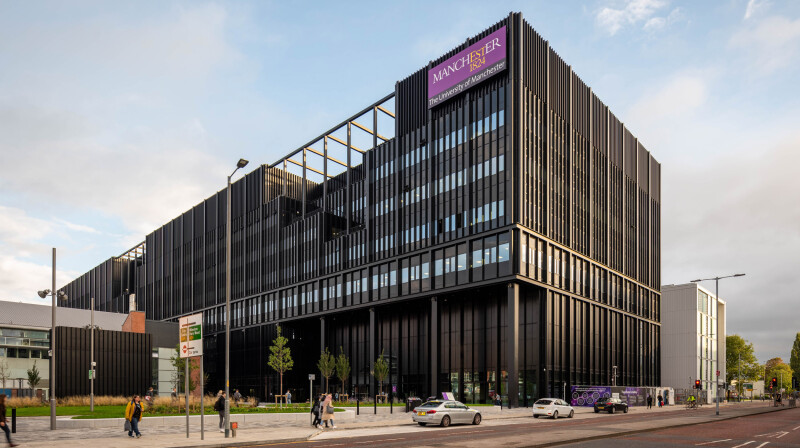
From the serene surroundings of All Saints Park to the imposing sight of the biggest university building in the North, this route takes you around Manchester Met’s campus and back again via new neighbourhoods and advanced materials.
This fine public space with its lawns and mature trees is a popular spot for sandwich breaks and meeting friends in almost any weather. If visiting on rare occasions when there is apparently nobody else in All Saints’ Park, do not fear being alone because you share the space with 16,000 fellow humans. Of course, you can’t see these people as they are dead, buried under the visitor’s feet. All Saints’ Park was formerly the churchyard for All Saints’ Church which opened in 1820 and disappeared after being bombed in 1940. The outline of the former church is picked out by low walls in the centre of the park. After WWII the churchyard became a playground but following the rash depopulation of the 1950s-60s, discussed below, the space was turned into a garden. The old church bell of All Saints’ church apparently resides in Noranda, Quebec, Canada, in another church of All Saints.
This Roman Catholic church (1967-8) on Lower Ormond Street, fringing All Saints’ Park, presents a darkly forbidding Modernist exterior from Desmond Williams & Associates. Nobody visits for that, instead, they go inside to view the stupendous ceramic masterpiece of Christ in Majesty by Robert Brumby, which speaks so eloquently of the best in 1960s artistic fashions. Brumby also designed the curious memorial plaque.
The second St Augustine church in Manchester, this is the third, was, just like All Saints’ church outside, destroyed in the 1940 Blitz. The memorial is crafted from mangled plate from the destroyed building. Also, look out for the utterly distinctive 1960s stained glass from the Whitefriars Studio.
This 1830s house, now part of Manchester Metropolitan University, was built for the Bellhouse family, notable iron founders and building contractors of nineteenth-century Manchester, pioneers across three generations. Buildings and structures built by the Bellhouses in Manchester include the warehouses of Liverpool Road Station (the world’s first passenger rail station), Campfield Markets in Castlefield, The Portico Library, Manchester Art Gallery and the arches and viaducts of the Manchester, South Junction and Altrincham Railway. The company also pioneered the use of corrugated-iron flat-pack houses. After the family vacated the property it became part of Manchester Ear Hospital, then a Manchester Met building.
Round the corner from the Bellhouse Building is the main HQ of Manchester Met which hides a treasure open to the public. Manchester Met Special Collections contains designs that have inspired generations of artists, engineers and creatives. The collection began in 1853 with the creation of the Manchester School of Art and was intended to inspire students. On the outside of the building is a plaque to Robert Angus Smith. In 1859 he was the first person to put two words together ‘acid’ and ‘rain’ following his studies of Manchester’s chemical-soup of an atmosphere at that time.
This seated statue of John Dalton is by William Theed and was previously in Piccadilly Gardens until it was relocated outside the former John Dalton College of Technology, here, in 1966. John Dalton (1766-1844) was a world-famous chemist, physicist and meteorologist. He was the father of the atomic theory and was the first to describe colour blindness which in many countries is called Daltonism. He was beloved in Manchester. His funeral was perhaps the largest funeral cortège ever held in the city’s history up to that point. The cortège had 95 carriages and more than 150,000 people lined the streets.
Curiously, not all of John Dalton made its way to Ardwick Cemetery. Colour blindness confounded him, so he donated his eyes to science. He wanted someone to work out why the condition was occurring, since he himself had failed to do so. Thus if people ask nicely in the Science and Industry Museum in Manchester, the curators might fetch Dalton’s eyeballs out of storage for you.
This huge development, completed in 2022, occupies the former site of the BBC in Manchester prior to the corporation’s move to The Quays in Salford. The masterplan for the area came from Feilden Clegg Bradley Studios – a favourite practice in these parts as we shall see. The mixed development of offices, flats, food and drink and retail divides opinion aesthetically with its aggressive and heavy purple terracotta finish and its curious name, but it has been successful commercially with several notable occupiers. The buildings surround Symphony Park, which has interesting raised ends to the north and south providing space underneath for various businesses. Next door to Circle Square is a 1966 building now Manchester Technology Centre which was originally the National Computing Centre. When this opened it chimed well with Prime Minister Harold Wilson’s ‘white heat of technology’ speech and the need for the UK to compete at the highest level in computing. It was a not-for-profit organisation to encourage computer users and usage.
There was disagreement in the late sixties and early seventies about the creation of new counties. It was a close-run thing but fortunately, this conurbation was named Greater Manchester. The other suggestion was an acronym of South East Lancashire and North East Cheshire which would have led to the name of SELNEC for the region. Yuck. Still, work had proceeded under this acronym including the SELNEC Highway Plan of 1962. This included provision for an elevated main road almost a kilometre in length smashing through the existing south centre of the city. It was opened by Prime Minister Harold Wilson in 1967 and has become a defining cultural feature appearing in music, literature and art.
The row of shops and takeaways are all that remain of a secondary retail hotspot outside the city centre which also extends down nearby Stretford Road. Two of the oldest retailers in the city are located in this stretch. Eighth Day from 1970 is the oldest vegetarian business in the city, it also incorporates a long-running café. Greater Manchester has been home to the Vegetarian Society since its creation in the 1840s. The Johnny Roadhouse store has been here since 1955. Johnny Roadhouse was a great Mancunian character and a celebrated session saxophonist who played with many of the great acts of the fifties and sixties. Paul McCartney, The Smiths and Oasis have been customers at the store.
The Manchester Engineering Campus Development has a name almost as long as the building so most people refer to it as just MECD. It is a breath-taking structure in scale lying between Grosvenor Street to the north and Booth Street East to the south, incorporating older structures, such as Oddfellows Hall. The building is 200m in length and there are 52 teaching spaces and four computer clusters. If you added up all the square footage it would amount to 11 football pitches.
The architects are Mecanoo, from the Netherlands, who seem to favour an obsidian look to their designs. HOME arts centre also by Mecanoo shares the same black shade as MECD. The genius of this building is how it works. It involves the passer-by on Grosvenor Street with a view into the High Voltage Laboratory with its science fiction-like equipment. Almost the entire eastern side of the building is essentially one long corridor on several levels. To walk that and see hundreds of students at work on digitally and electronically hooked-up desks can’t help but fill the soul with optimism about the future.
The National Graphene Institute is another black building but by Jestico and Whiles. It opened in 2015 to exploit graphene, the ‘world’s thinnest material’. This was isolated and investigated by Andre Geim and Konstantin Novoselov at the University of Manchester, for which they received the Nobel Prize in 2010. The building sits on the site of the Albert Club, a club for Manchester’s nineteenth-century ex-patriot German community. Communist Manifesto co-author Friedrich Engels was a member of the club from his arrival in Manchester in 1842 and throughout most of the 22 years, on and off, he spent here.
Sir Charles Hallé, the man who created Manchester’s famous Hallé Orchestra in 1858, set up the Manchester Royal College of Music in 1893. He was its first principal. In 1972 the college merged with the Northern College of Music to create the conservatoire of the Royal Northern College of Music. The building dates from 1973 designed by Bilkerdike, Allen and Rich. It has a fortress-like exterior, but the interior is much better, forming a long and climbing processional way from the catering areas up to the auditoria. Hallé lived not far away in Moss Side. He was a very popular figure and when he died more than 100,000 people lined the streets for his cortège. One Christmas when the postman arrived drunk, having been supplied with too many ‘tots’ of drink at other houses, Hallé delivered the rest of the post so the man could recover and keep his job.
Manchester Met’s School of Digital Arts (SODA) designed by Feilden Clegg Bradley is a simple building in form literally illuminated by lighting effects. It presents a dramatic scene at night. To quote: ‘The state-of-the-art building has a digital innovation lab, green screens, edit suites, screening space, a media gallery, sound and music studios and production studios.’ SODA sits next to the sweetly proportioned, tile-enlivened Salutation pub. There was a Salutation pub here in the 1840s although the present exterior is from the early twentieth century. The pub retains its pleasant multi-roomed interior with some original features. The plaque on the wall marks the occasion in 1846, when, nearby, the Reverend Patrick Bronte lodged with his daughter Charlotte. He was here for a cataract operation. Charlotte Bronte’s novel Jane Eyre would be published the year after. In 1850 Charlotte became a friend of Manchester-based writer Elizabeth Gaskell who would later write her friend’s biography.
This is the oldest undergraduate school of art in the country and dates from 1853. It is presently made up of a complicated sequence of buildings. First, there is the building on Boundary Street West from 2014, which as with SODA, was designed by Feilden Clegg Bradley. The building allows people to gaze into the light-filled circulation areas with pale oak fittings on crisscrossing stairways and bridges. Round the corner on Higher Ormond Street and connected by an entertaining sixties bridge are the older School of Art buildings.
The bridge connects with the School of Art Extension from 1897 by J Gibbon Sankey. The extension features an exquisite terracotta Arts and Crafts commemoration panel. The panel marks the donation of £10,000 from the profits of the Royal Manchester Jubilee Exhibition of 1887 to build the School of Art Extension. It was always intended the profits from the Exhibition would ‘be used to promote technical education and that as a survival we may have a permanent exhibition in the interests of utility and beauty’.
Round the corner on Grosvenor Street is the oldest part of Manchester School of Art from 1880-1 designed by GT Redmayne. It houses the Holden Gallery of Manchester Met. The entrance features excellent stone carving. French artist Adolphe Valette was a teacher here from 1902-1907. He did his best work in Manchester; Impressionist paintings of the industrial city transmuted into an almost magical ethereal place, with buildings softened and dissolved within the richly chemical atmosphere that Robert Angus Smith had noted. A pupil of Valette’s was Laurence Stephen Lowry whose distinctive work was shaped by his master. The influence can be clearly seen in Valette’s Old Cab at All Saints from 1911.
Cavendish Street here connected with Stretford Road to the west. Most British cities suffered massive de-population in the fifties, sixties and seventies of the twentieth century. The motivation for this was a good one although, tellingly, there was no consultation from middle-class planners with the working-class people who would be moved. Influenced by the Garden City movement the idea was to reduce the density of the inner-suburb populations by building spacious council estates with plenty of fresh air, gardens and basic amenities such as inside bathrooms. This area, Hulme, was scheduled for a particular radical re-working due to the terrible condition of the housing stock. The whole place was rebuilt in the form of deck-access low rises plus taller blocks of flats.
The result was that from a high of 130,000 people resident in the area in the mid-years of the twentieth century, there were only around 12,000 residents by the early seventies. As a council report put it not long after the redevelopment was completed in Hulme: ‘The development was unsuitable for families, the elderly and the disabled and the ‘streets in the sky never really functioned as envisaged’.
As one former resident said, who was moved to Hattersley, 12 miles away, high on the hills to the east. “We were city people, you know. It was a fifteen-minute walk to the city centre shops such as Lewis’s and Kendals, we had all the pubs and shops on Stretford Road as well. Suddenly we were in flats on the moors, and we weren’t asked you know, we were just told it was good for us. There wasn’t even a pub open when we arrived and it was more than an hour back into ‘town’ on the bus.”
By the late nineties, nearly all the sixties work had been demolished and houses returned to Hulme again, all this end of Stretford Road had become university territory by then. In the end, a generation of people suffered from an experiment in city planning that went disastrously wrong.
The handsome classical building next to the School of Art on Cavendish Street is the former Chorlton-on-Medlock Town Hall and Dispensary from 1831, now a façade for Manchester Met’s Grosvenor East Building, named after a prominent educationalist. The architect for the Neo-Greek building was Richard Lane, who designed similar buildings at the Quaker’s Meeting House in Mount Street and at the old Salford Town Hall in Bexley Square, although this one at Manchester Met is the best of the lot. Alfred Waterhouse, who designed the oldest part of the University of Manchester buildings not far away, was a pupil of Lane.
A momentous international event happened at Chorlton-on-Medlock Town Hall between 14-22 October 1945: the fifth Pan-African Congress. Famous names such as Jomo Kenyatta and Kwame Nkrumah attended and the event was chaired by veteran West Indian journalist and campaigner, George Padmore. One of the resolutions affirmed, ‘the right of all colonial peoples to control their own destiny.’ The Manchester congress was a vital step to independence in Africa and the West Indies. As Kenyatta would say, this was ‘a landmark in the…struggle for unity and freedom’. Resolutions passed included one calling for racial discrimination to be made a criminal offence years before such a measure was enacted. The Congress’s ‘Challenge to the Colonial Powers’ included the words: ‘We are determined to be free. We want education. We want the right to earn a decent living; the right to express our thoughts and emotions, to adopt and create our forms of beauty.’
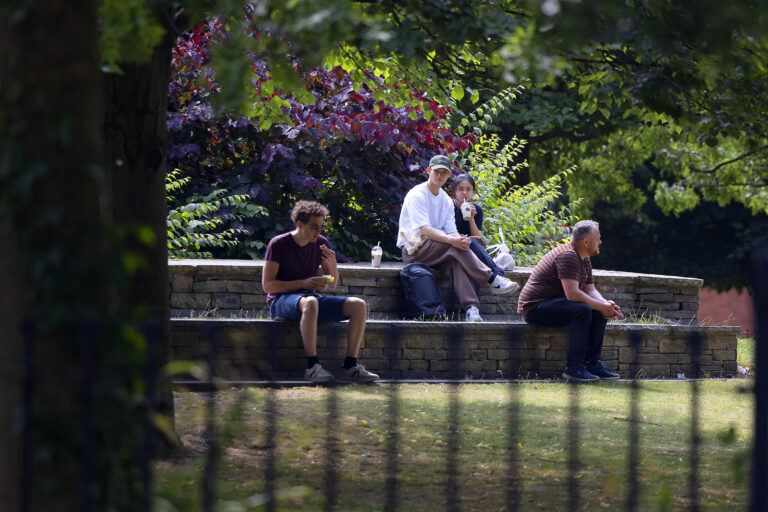
All Saints’ Park
This fine public space with its lawns and mature trees is a popular spot for sandwich breaks and meeting friends in almost any weather. If visiting on rare occasions when there is apparently nobody else in All Saints’ Park, do not fear being alone because you share the space with 16,000 fellow humans. Of course, you can’t see these people as they are dead, buried under the visitor’s feet. All Saints’ Park was formerly the churchyard for All Saints’ Church which opened in 1820 and disappeared after being bombed in 1940. The outline of the former church is picked out by low walls in the centre of the park. After WWII the churchyard became a playground but following the rash depopulation of the 1950s-60s, discussed below, the space was turned into a garden. The old church bell of All Saints’ church apparently resides in Noranda, Quebec, Canada, in another church of All Saints.
St Augustine’s Catholic Church
This Roman Catholic church (1967-8) on Lower Ormond Street, fringing All Saints’ Park, presents a darkly forbidding Modernist exterior from Desmond Williams & Associates. Nobody visits for that, instead, they go inside to view the stupendous ceramic masterpiece of Christ in Majesty by Robert Brumby, which speaks so eloquently of the best in 1960s artistic fashions. Brumby also designed the curious memorial plaque.
The second St Augustine church in Manchester, this is the third, was, just like All Saints’ church outside, destroyed in the 1940 Blitz. The memorial is crafted from mangled plate from the destroyed building. Also look out for the utterly distinctive 1960s stained glass from the Whitefriars Studio.
The Bellhouse
This 1830s house, now part of Manchester Metropolitan University, was built for the Bellhouse family, notable iron founders and building contractors of nineteenth-century Manchester, pioneers across three generations. Buildings and structures built by the Bellhouses in Manchester include the warehouses of Liverpool Road Station (the world’s first passenger rail station), Campfield Markets in Castlefield, The Portico Library, Manchester Art Gallery and the arches and viaducts of the Manchester, South Junction and Altrincham Railway. The company also pioneered the use of corrugated-iron flat-pack houses. After the family vacated the property it became part of Manchester Ear Hospital, then a Manchester Met building.
Manchester Met University Special Collections & All Saints Library
Round the corner from the Bellhouse Building is the main HQ of Manchester Met which hides a treasure open to the public. Manchester Met Special Collections contains designs that have inspired generations of artists, engineers and creatives. The collection began in 1853 with the creation of the Manchester School of Art and was intended to provide inspiration for students. On the outside of the building is a plaque to Robert Angus Smith. In 1859 he was the first person to put two words together ‘acid’ and ‘rain’ following his studies of Manchester’s chemical-soup of an atmosphere at that time.
John Dalton Statue, Chester Street
This seated statue of John Dalton is by William Theed and was previously in Piccadilly Gardens until it was relocated outside the former John Dalton College of Technology, here, in 1966. John Dalton (1766-1844) was a world-famous chemist, physicist and meteorologist. He was the father of the atomic theory and was the first to describe colour blindness which in many countries is called Daltonism. He was beloved in Manchester. His funeral was perhaps the largest funeral cortège ever held in the city’s history up to that point. The cortège had 95 carriages and more than 150,000 people lined the streets.
Curiously, not all of John Dalton made its way to Ardwick Cemetery. Colour blindness confounded him, so he donated his eyes to science. He wanted someone to work out why the condition was occurring since he himself had failed to do so. Thus if people ask nicely in the Science and Industry Museum in Manchester, the curators might fetch Dalton’s eyeballs out of storage for you.
Circle Square, former National Computing Centre and Hatch
This huge development, completed in 2022, occupies the former site of the BBC in Manchester before the corporation’s move to The Quays in Salford. The masterplan for the area came from Feilden Clegg Bradley Studios – a favourite practice in these parts as we shall see. The mixed development of offices, flats, food and drink and retail divides opinion aesthetically with its aggressive and heavy purple terracotta finish and its curious name, but it has been successful commercially with several notable occupiers. The buildings surround Symphony Park, which has interesting raised ends to the north and south providing space underneath for various businesses. Next door to Circle Square is a 1966 building now Manchester Technology Centre which was originally the National Computing Centre. When this opened it chimed well with Prime Minister Harold Wilson’s ‘white heat of technology’ speech and the need for the UK to compete at the highest level in computing. It was a not-for-profit organisation to encourage computer users and usage. Next-door again and under the shadow of the Mancunian Way is Hatch, an entertaining and voguish collection of shipping containers providing a variety of food, drink and retail experiences.
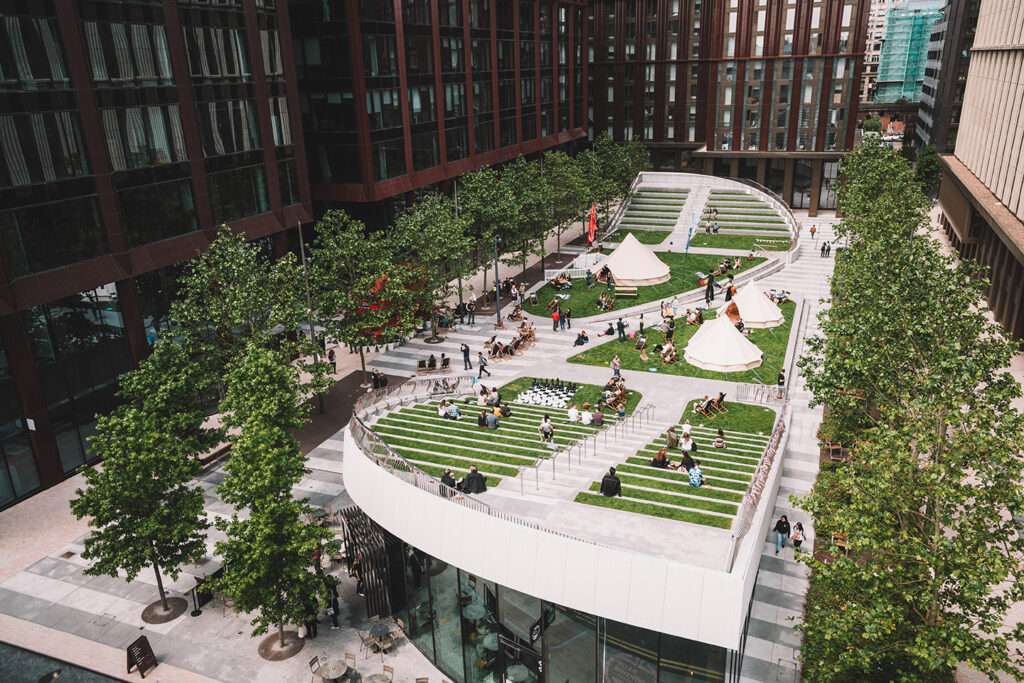
Mancunian Way
There was disagreement in the late sixties and early seventies about the creation of new counties. It was a close-run thing but fortunately, this conurbation was named Greater Manchester. The other suggestion was an acronym of South East Lancashire and North East Cheshire which would have led to the name of SELNEC for the region. Yuck. Still, work had proceeded under this acronym including the SELNEC Highway Plan of 1962. This included provision for an elevated main road almost a kilometre in length smashing through the existing south centre of the city. It was opened by Prime Minister Harold Wilson in 1967 and has become a defining cultural feature appearing in music, literature and art.
Shops – Oxford Road
The row of shops and takeaways are all that remain of a secondary retail hotspot outside the city centre which also extends down nearby Stretford Road. Two of the oldest retailers in the city are located in this stretch. Eighth Day from 1970 is the oldest vegetarian business in the city, it also incorporates a long-running café. Greater Manchester has been home to the Vegetarian Society since its creation in the 1840s. The Johnny Roadhouse store has been here since 1955. Johnny Roadhouse was a great Mancunian character and a celebrated session saxophonist who played with many of the great acts of the fifties and sixties. Paul McCartney, The Smiths and Oasis have been customers at the store.
MECD
The Manchester Engineering Campus Development has a name almost as long as the building so most people refer to it as just MECD. It is a breath-taking structure in scale lying between Grosvenor Street to the north and Booth Street East to the south, incorporating older structures, such as Oddfellows Hall. The building is 200m in length and there are 52 teaching spaces and four computer clusters. If you added up all the square footage it would amount to 11 football pitches.
The architects are Mecanoo, from the Netherlands, who seem to favour an obsidian look to their designs. HOME arts centre also by Mecanoo shares the same black shade as MECD. The genius of this building is how it works. It involves the passer-by on Grosvenor Street with a view into the High Voltage Laboratory with its science fiction-like equipment. Almost the entire eastern side of the building is essentially one long corridor on several levels. To walk that and see hundreds of students at work on digitally and electronically hooked-up desks can’t help but fill the soul with optimism about the future.
National Graphene Institute
The National Graphene Institute is another black building but by Jestico and Whiles. It opened in 2015 to exploit graphene, the ‘world’s thinnest material’. This was isolated and investigated by Andre Geim and Konstantin Novoselov at the University of Manchester, for which they received the Nobel Prize in 2010. The building sits on the site of the Albert Club, a club for Manchester’s nineteenth-century ex-patriot German community. Communist Manifesto co-author Friedrich Engels was a member of the club from his arrival in Manchester in 1842 and throughout most of the 22 years, on and off, he spent here.
RNCM
Sir Charles Hallé, the man who created Manchester’s famous Hallé Orchestra in 1858, set up the Manchester Royal College of Music in 1893. He was its first principal. In 1972 the college merged with the Northern College of Music to create the conservatoire of the Royal Northern College of Music. The building dates from 1973 designed by Bilkerdike, Allen and Rich. It has a fortress-like exterior, but the interior is much better, forming a long and climbing processional way from the catering areas up to the auditoria. Hallé lived not far away in Moss Side. He was a very popular figure and when he died more than 100,000 people lined the streets for his cortège. One Christmas when the postman arrived drunk, having been supplied with too many ‘tots’ of drink at other houses, Hallé delivered the rest of the post so the man could recover and keep his job.
SODA and the Salutation
Manchester Met’s School of Digital Arts (SODA) designed by Feilden Clegg Bradley is a simple building in form literally illuminated by lighting effects. It presents a dramatic scene at night. To quote: ‘The state-of-the-art building has a digital innovation lab, green screens, edit suites, screening space, a media gallery, sound and music studios and production studios.’ SODA sits next to the sweetly proportioned, tile-enlivened Salutation pub. There was a Salutation pub here in the 1840s although the present exterior is from the early twentieth century. The pub retains its pleasant multi-roomed interior with some original features. The plaque on the wall marks the occasion in 1846, when, nearby, the Reverend Patrick Bronte lodged with his daughter Charlotte. He was here for a cataract operation. Charlotte Bronte’s novel Jane Eyre would be published the year after. In 1850 Charlotte became a friend of Manchester-based writer Elizabeth Gaskell who would later write her friend’s biography.
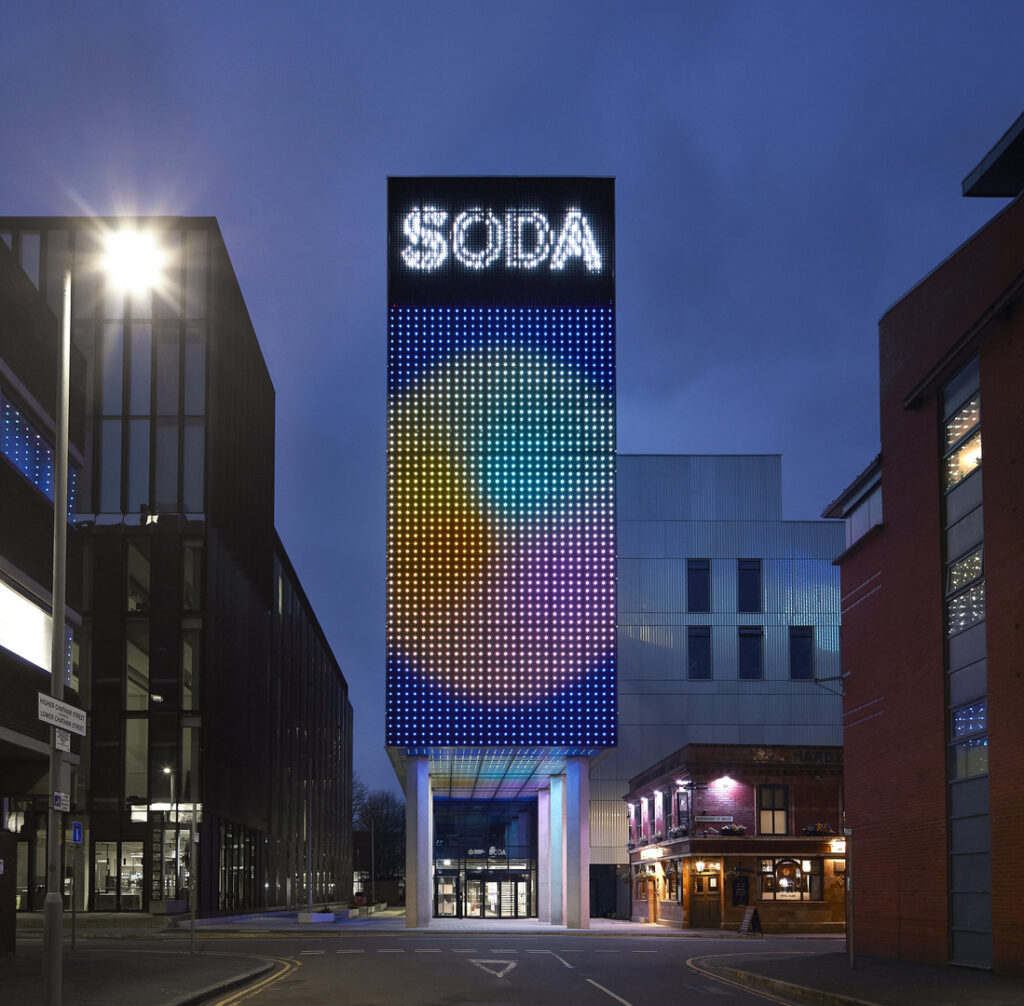
Manchester School of Art
This is the oldest undergraduate school of art in the country and dates from 1853. It is presently made up of a complicated sequence of buildings. First, there is the building on Boundary Street West from 2014, which as with SODA, was designed by Feilden Clegg Bradley. The building allows people to gaze into the light-filled circulation areas with pale oak fittings on crisscrossing stairways and bridges. Round the corner on Higher Ormond Street and connected by an entertaining sixties bridge are the older School of Art buildings.
The bridge connects with the School of Art Extension from 1897 by J Gibbon Sankey. The extension features an exquisite terracotta Arts and Crafts commemoration panel. The panel marks the donation of £10,000 from the profits of the Royal Manchester Jubilee Exhibition of 1887 to build the School of Art Extension. It was always intended the profits from the Exhibition would ‘be used to promote technical education and that as a survival we may have a permanent exhibition in the interests of utility and beauty’.
Round the corner on Grosvenor Street is the oldest part of Manchester School of Art from 1880-1 designed by GT Redmayne. It houses the Holden Gallery of Manchester Met. The entrance features excellent stone carving. French artist Adolphe Valette was a teacher here from 1902-1907. He did his best work in Manchester; Impressionist paintings of the industrial city transmuted into an almost magical ethereal place, with buildings softened and dissolved within the richly chemical atmosphere that Robert Angus Smith had noted. A pupil of Valette’s was Laurence Stephen Lowry whose distinctive work was shaped by his master. The influence can be clearly seen in Valette’s Old Cab at All Saints from 1911.
Slum clearances
Cavendish Street here connected with Stretford Road to the west. Most British cities suffered massive de-population in the fifties, sixties and seventies of the twentieth century. The motivation for this was a good one although, tellingly, there was no consultation from middle-class planners with the working-class people who would be moved. Influenced by the Garden City movement the idea was to reduce the density of the inner-suburb populations by building spacious council estates with plenty of fresh air, gardens and basic amenities such as inside bathrooms. This area, Hulme, was scheduled for a particular radical reworking due to the terrible condition of the housing stock. The whole place was rebuilt in the form of deck-access low rises plus taller blocks of flats.
The result was that from a high of 130,000 people resident in the area in the mid-years of the twentieth century, there were only around 12,000 residents by the early seventies. As a council report put it not long after the redevelopment was completed in Hulme: ‘The development was unsuitable for families, the elderly and the disabled and the ‘streets in the sky never really functioned as envisaged’.
As one former resident said, who was moved to Hattersley, 12 miles away, high on the hills to the east. “We were city people, you know. It was a fifteen-minute walk to the city centre shops such as Lewis’s and Kendals, we had all the pubs and shops on Stretford Road as well. Suddenly we were in flats on the moors, and we weren’t asked you know, we were just told it was good for us. There wasn’t even a pub open when we arrived and it was more than an hour back into ‘town’ on the bus.”
By the late nineties, nearly all the sixties work had been demolished and houses returned to Hulme again, all this end of Stretford Road had become university territory by then. In the end, a generation of people suffered from an experiment in city planning that went disastrously wrong.
Chorlton-on-Medlock Town Hall
The handsome classical building next to the School of Art on Cavendish Street is the former Chorlton-on-Medlock Town Hall and Dispensary from 1831, now a façade for Manchester Met’s Grosvenor East Building, named after a prominent educationalist. The architect for the Neo-Greek building was Richard Lane, who designed similar buildings at the Quaker’s Meeting House in Mount Street and at the old Salford Town Hall in Bexley Square, although this one at Manchester Met is the best of the lot. Alfred Waterhouse, who designed the oldest part of the University of Manchester buildings not far away, was a pupil of Lane.
A momentous international event happened at Chorlton-on-Medlock Town Hall between 14-22 October 1945: the fifth Pan-African Congress. Famous names such as Jomo Kenyatta and Kwame Nkrumah attended and the event was chaired by veteran West Indian journalist and campaigner, George Padmore. One of the resolutions affirmed, ‘the right of all colonial peoples to control their own destiny.’ The Manchester congress was a vital step to independence in Africa and the West Indies. As Kenyatta would say, this was ‘a landmark in the…struggle for unity and freedom’. Resolutions passed included one calling for racial discrimination to be made a criminal offence years before such a measure was enacted. The Congress’s ‘Challenge to the Colonial Powers’ included the words: ‘We are determined to be free. We want education. We want the right to earn a decent living; the right to express our thoughts and emotions, to adopt and create our forms of beauty.’
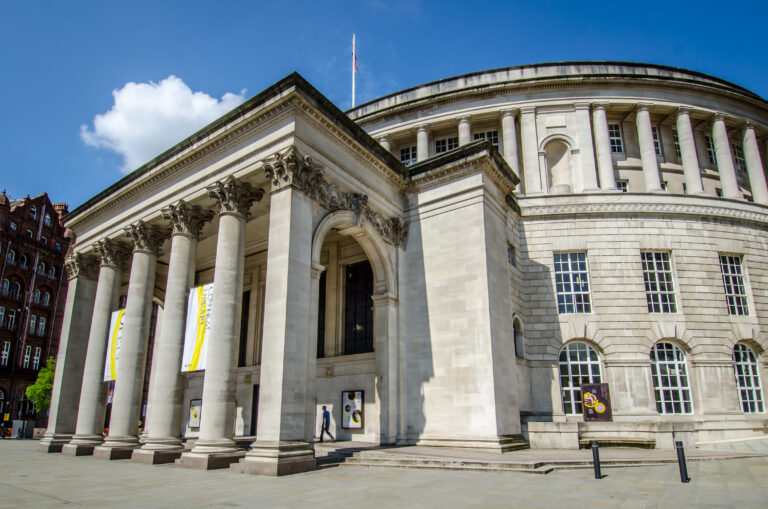
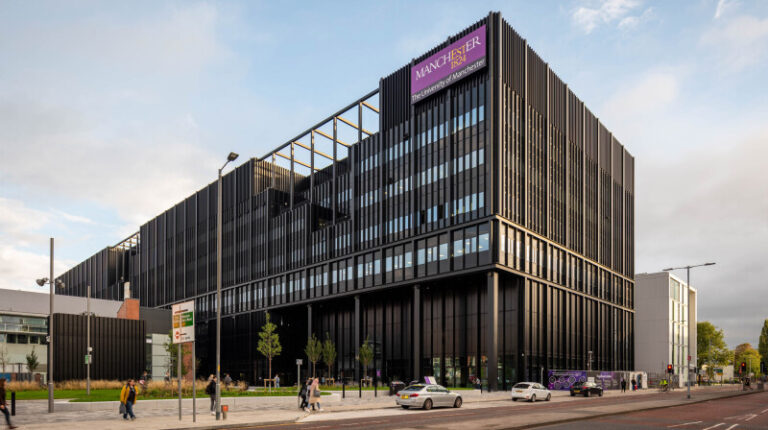
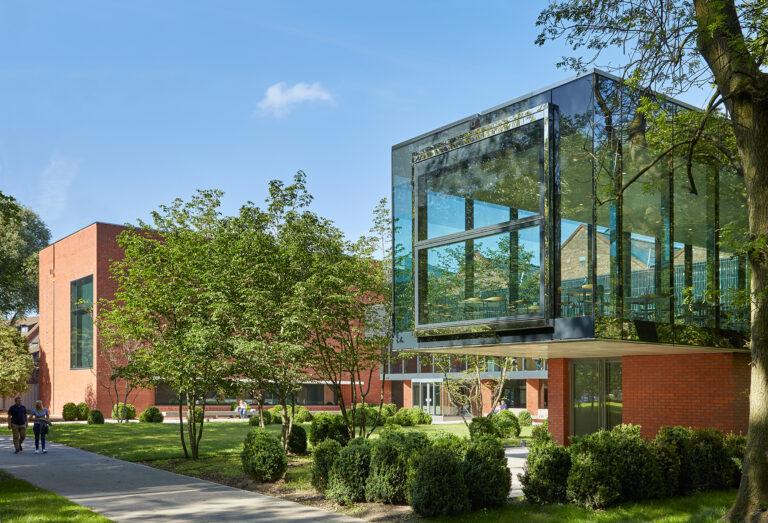

Some of the best Galleries & Museums in Manchester are here on Oxford Road Corridor. Explore a diverse programme for all cultural enthusiasts.
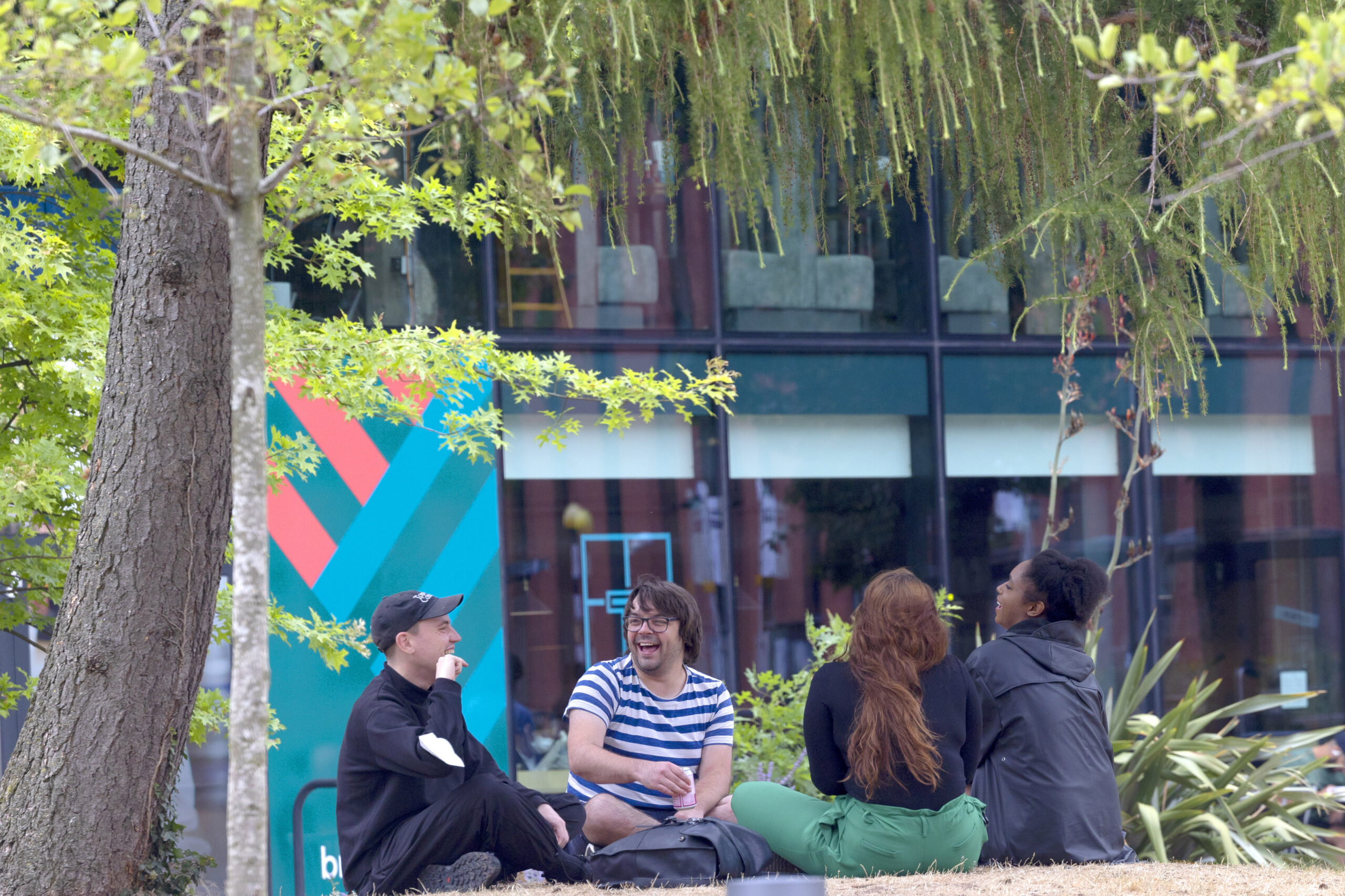
Oxford Road Corridor has a number of historic parks and contemporary green spaces to enjoy.
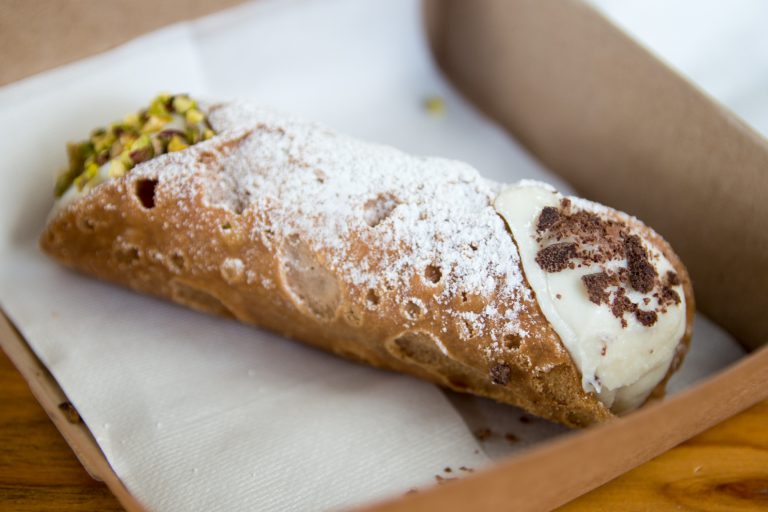
The food and drink in Manchester is some of the best in the UK with many of the finest offerings found here on the Oxford Road Corridor.